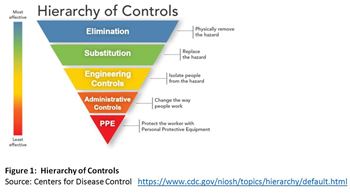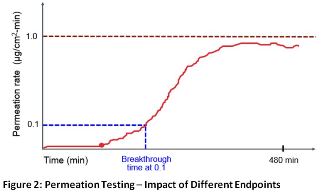
Chemical Protective Clothing Selection—Finding the Best Match for Your Hazard
You should strive to gather permeation data for the CPC you plan to use against your actual workplace chemicals.
- By Susan Lovasic
- May 01, 2019
Safety professionals deal with many workplace hazards, and most employ the "Hierarchy of Controls" shown in Figure 1 to reduce/eliminate hazards. If possible, eliminate the hazard completely or substitute a safer option. Next, apply engineering controls to minimize worker contact. If that is not 100 percent effective, then administrative controls such as work practices are modified to minimize potential contact. After all these steps are completed, then personal protective equipment (PPE) options are selected for any residual risk.

Selection of PPE is the responsibility of USA general industry employers under OSHA 29 CFR 1910.132, Personal Protective Equipment. Employer assessment of workplace hazards drives the selection of appropriate PPE. This article will focus on PPE selection against chemical hazards.
Hazard Assessments
For proper selection of chemical protective clothing (CPC) as PPE, there are several questions to be considered during the hazard assessment. First, what is the hazardous chemical's name, Chemical Abstracts Service (CAS) Registry number, and the chemical’s physical state (solid, liquid, gas)? Many industries use their own chemical names or acronyms. It is best to use the CAS # so that you and the CPC manufacturer are discussing the same chemical. Additionally, is the chemical a mixture and what are the components? A hazardous component could breach the barrier material when part of a mixture when it would not do so in pure form.
Second, how is the chemical a skin hazard? Will it cause skin irritation or burn? Can the chemical be absorbed through the skin and cause acute or chronic health effects? It is important to consider that some materials, such as asbestos or lead, are not listed as skin hazards, but if these particles get onto the worker's skin or clothing, they can be transferred and become inhalation or ingestion hazards in or away from the workplace.
Finally, consider the potential exposure scenario. This is best done by direct observation of the work. What are the work practices? Is chemical exposure expected to occur frequently or only when something fails in the process or when a specific non-routine work task (e.g., line break) is conducted? Consider how much of the chemical could be released and in what direction. The exposure scenario should consider likelihood of contact with the chemical and if contact occurs, the amount, duration, and direction.
Once the chemical hazard assessment has been completed, then CPC selection can begin. There are three key aspects of CPC that should be considered: fabric, seam, and garment design. This article will focus chiefly on barrier properties of fabric used in CPC.
There may be other special hazards to consider, such as flammable/explosive environment, extreme heat or cold, physical hazards, etc. These special needs are not covered in this article, but if they apply to your workplace, they must be addressed. Also, remember that CPC is often an element of a protective ensemble. You must validate that the wearer is fully protected from all hazards, including respiratory.
Chemical Barrier Assessments of CPC Materials
A material's chemical resistance can be measured several ways: degradation, penetration, and permeation. Permeation is the most accurate option, but we will discuss the other two, as well.
Degradation is usually reported only for chemical glove materials and is rarely reported for chemical suit materials. Degradation assesses the compatibility of the material with the chemical, rather than measuring its barrier properties. Degradation occurs when there is a change in the exposed material, such as did the material swell or become brittle or lose weight? If the material shows degradation due to the chemical, then it is clearly not a candidate to provide barrier. However, if the material shows no degradation, that result does not prove the material will provide any barrier to that chemical.
Penetration testing is another way CPC materials can be assessed. This testing will determine whether there is bulk flow of a chemical through voids in the material. These voids can include gaps, pores, holes, and imperfections. The most common liquid penetration test for CPC is ASTM F903. In this method, a sample of the material is sealed inside a cell and one side of the cell is filled with a liquid chemical (gases cannot be tested). This test is most commonly performed for 60 minutes with pressure applied for some of the test period. The back side of the material is monitored to note any visible test liquid penetration. If liquid was observed, then the material failed. ASTM F903 gives a visual pass/fail assessment only; it is a qualitative rather than quantitative measurement of liquid barrier.
Barrier to particles also can be checked with penetration testing. In this case, particles of known size distribution, typically salt or latex spheres, are generated in a laboratory. Actual hazardous particles are not used. A material's ability to block penetration of particles of different sizes is most relevant to its level of protection—not the particle’s exact composition. Test results are reported as percent filtration efficiency for the specific particle size tested.
The most accurate way to assess chemical barrier is permeation testing. It measures chemical migration through a material at a molecular level via a three-stage process: absorption into the material on the outside, diffusion through the material, and desorption or release from the material to the inside. Permeation is different from penetration because it does not require a void/defect in the material.
The most common permeation test is ASTM F739, which can be run using liquid or gas chemicals. The test material is sealed in a cell between two chambers. One chamber is filled with the test chemical, which stays in direct contact with the material for the test duration. The other chamber contains a media (typically water or nitrogen) to collect the test chemical. The collection side is periodically sampled. Sophisticated analytical techniques are used to determine if, when, and how much test chemical passed through the material in a set time period. The reported value for F739 is the time lapse from initial contact to when the chemical reached a permeation rate of 0.10 ug/cm2-min.
Permeation is a very sensitive test and provides quantitative results. Due to unique chemical/barrier material exposure responses, you should strive to gather permeation data for the CPC you plan to use against your actual workplace chemicals.
Permeation Tests—A Closer Look at Reported Results
For permeation testing, it is important to be aware that some CPC manufacturers might report permeation results using a permeation rate of 1.0 ug/cm2-min. That is 10X less stringent than ASTM F739, which has an endpoint permeation rate of 0.10 ug/cm2-min. This difference in reported value criteria is critical for proper CPC selection. Figure 2 represents a typical permeation curve for an eight-hour test. Initially there is no chemical permeation detected, then there is an increase in permeation rate, then a leveling off at the steady state permeation rate. The steady state permeation rate for this chemical stayed below the 1.0 ug/cm2-min threshold, so it would be reported that no permeation was detected after eight hours (480 minutes). But clearly the chemical did permeate through the material for most of the test. If you had access to this permeation curve, you would see this issue. But if you are only provided a breakthrough time reported as >480 minutes, you might incorrectly assume that this material offered longer barrier than another material tested using the endpoint of 0.10 ug/cm2-min. It is important that CPC material permeation data be compared using ASTM F739 results with the 0.10 ug/cm2-min criteria, as it is more stringent. Be sure to check what test method and what endpoint was used for any CPC material permeation claims.

Full Scale CPC Tests
In addition to chemical tests run on CPC materials previously described, testing also can be conducted to assess overall garment design or an ensemble of garment, gloves, respirator, etc. There are tests (ASTM or ISO methods) to check gas tightness, vapor inward leakage, and particle inward leakage of CPC. There also are many test methods to assess "liquid integrity" of CPC garments and ensembles.
A "passing" rating for full-scale tests does not mean that the garment/ensemble is 100 percent impervious to a specific hazardous chemical phase. For example, just because a garment holds out low surface tension water in a shower test does not mean that the garment will hold out liquid toluene under the same exposure scenario. You must still rely on permeation test data for specific chemical hazards. Even with this limitation, full garment/ensemble tests are an excellent way to assess the robustness of a garment design and to evaluate PPE ensemble interfaces.
Summary
Safety professionals' decisions regarding CPC selection will directly impact the health and safety of workers. The more questions you ask when selecting CPC, the greater your ability to find the best match for your chemical hazards.
This article originally appeared in the May 2019 issue of Occupational Health & Safety.